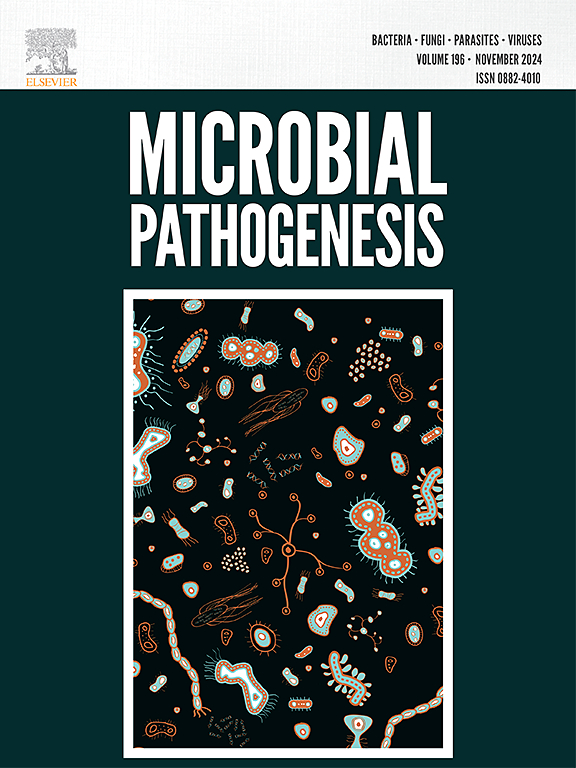幽门螺杆菌相关MicroRNA和转录网络在胃发病机制:探索表观遗传对话景观。
IF 3.3
3区 医学
Q3 IMMUNOLOGY
引用次数: 0
摘要
幽门螺杆菌感染的致病性是胃病如溃疡和癌症的一个有充分证据的危险因素。然而,其致病作用的分子机制仅被部分理解。为了解决研究空白,本研究利用综合生物信息学方法在表观遗传水平上鉴定与幽门螺杆菌相关的高危基因的关键microrna (mirna)。所讨论的mirna,包括hsa-mir-539、hsa-mir-361、hsa-mir-203a、hsa-mir-7-1、hsa-let-7f-1、hsa-mir-133a-1和hsa-mir-186,通过严格的数据库搜索和交叉参考进行验证。通过整理miRNet和其他miRNA平台,该研究揭示了这些miRNA和转录因子(tf)(如雄激素受体(AR)、BCL6和GATA1)之间复杂的调控网络。这些相互作用在炎症和致癌途径中起着至关重要的作用。mirna的功能注释强调了它们在与幽门螺杆菌感染和胃癌进展相关的基本生物学过程和途径中的重要作用。总的来说,这一综合分析为幽门螺杆菌诱导的溃疡和癌变的分子景观提供了关键的见解。这些信息可能为未来肠道健康管理的研究和临床应用提供潜在的生物标志物和治疗靶点。本文章由计算机程序翻译,如有差异,请以英文原文为准。

Helicobacter pylori associated MicroRNA and transcriptional networks in gastric pathogenesis: Exploring the epigenetic dialogue landscape
The pathogenicity of Helicobacter pylori infection is a well-documented risk factor for gastric ailments such as ulcer and cancer. However, the molecular mechanisms that underlie its pathogenic effects are only partially understood. To address the research gap, this study utilizes a comprehensive bioinformatic approach to identify key microRNAs (miRNAs) that target high-risk genes associated with H. pylori at an epigenetic level. The miRNAs in question, including hsa-mir-539, hsa-mir-361, hsa-mir-203a, hsa-mir-7-1, hsa-let-7f-1, hsa-mir-133a-1, and hsa-mir-186, were validated through rigorous database searches and cross-referencing. By curating the miRNet and other miRNA platforms, the study uncovered intricate regulatory networks between these miRNAs and transcription factors (TFs) such as androgen receptor (AR), BCL6, and GATA1. These interactions play a crucial role in inflammatory and carcinogenic pathways. The functional annotation of the miRNAs highlights their significant roles in essential biological processes and pathways that are relevant to H. pylori infection and gastric cancer progression. Overall, this integrated analysis provides critical insights into the molecular landscape of H. pylori-induced ulceration and carcinogenesis. This information may offer potential biomarkers and therapeutic targets for future research and clinical applications in managing gut health.
求助全文
通过发布文献求助,成功后即可免费获取论文全文。
去求助
来源期刊

Microbial pathogenesis
医学-免疫学
CiteScore
7.40
自引率
2.60%
发文量
472
审稿时长
56 days
期刊介绍:
Microbial Pathogenesis publishes original contributions and reviews about the molecular and cellular mechanisms of infectious diseases. It covers microbiology, host-pathogen interaction and immunology related to infectious agents, including bacteria, fungi, viruses and protozoa. It also accepts papers in the field of clinical microbiology, with the exception of case reports.
Research Areas Include:
-Pathogenesis
-Virulence factors
-Host susceptibility or resistance
-Immune mechanisms
-Identification, cloning and sequencing of relevant genes
-Genetic studies
-Viruses, prokaryotic organisms and protozoa
-Microbiota
-Systems biology related to infectious diseases
-Targets for vaccine design (pre-clinical studies)
 求助内容:
求助内容: 应助结果提醒方式:
应助结果提醒方式:


